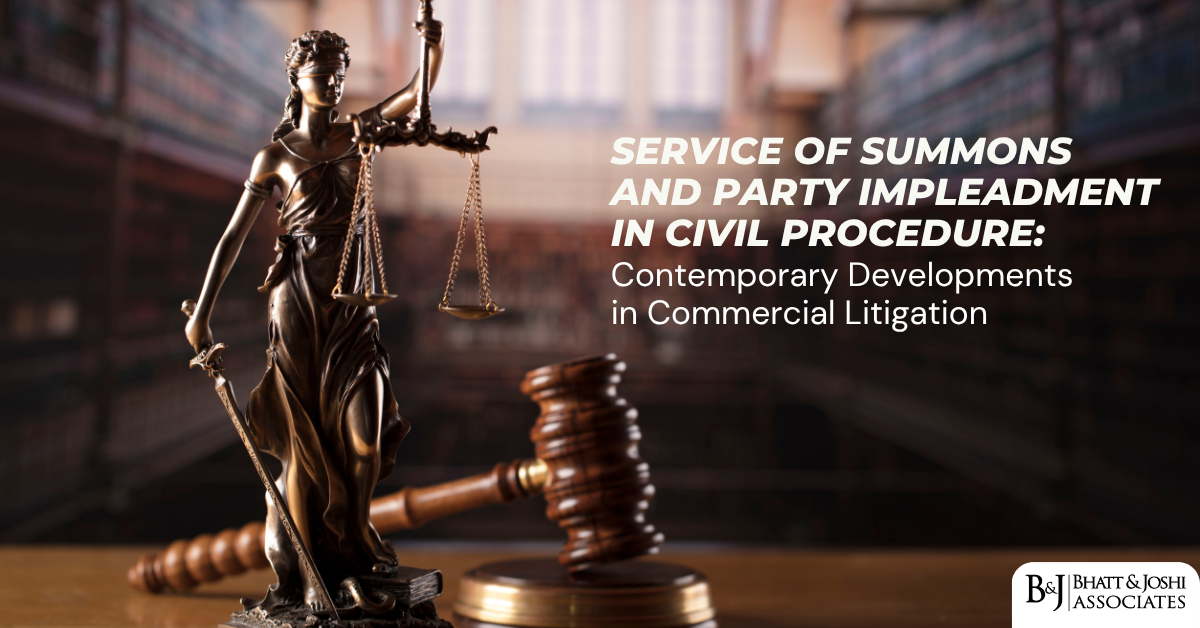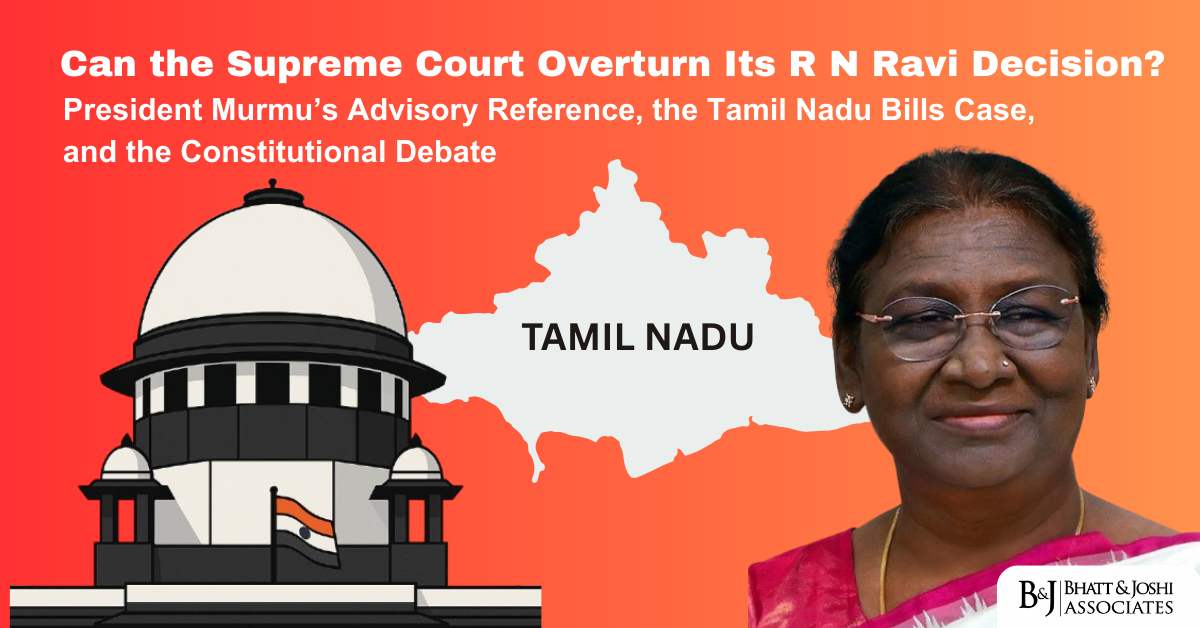Introduction
The procedural framework governing civil procedure law in India has undergone significant refinement through recent judicial pronouncements, particularly in the context of commercial disputes. Two landmark decisions from 2025 have clarified essential aspects of civil procedure: the Bombay High Court’s ruling in Anil Dhanraj Jethani and another v. Firoz A. Nadiadwala and others [1] regarding service of summons in transferred commercial suits, and the Supreme Court’s comprehensive analysis in Sulthan Said Ibrahim v. Prakasan & Ors [2] concerning party impleadment and the doctrine of res judicata. These decisions establish crucial precedents for procedural compliance in modern commercial litigation while addressing the interplay between traditional civil procedure law and specialized commercial courts legislation.
The evolution of civil procedure law, particularly following the enactment of the Commercial Courts Act, 2015 [3], has necessitated judicial clarification on various procedural nuances. Courts have been tasked with reconciling the rigorous procedural requirements imposed by the amended Civil Procedure Code with the practical realities of ongoing litigation that predates these legislative changes. This article examines these developments within the broader framework of procedural jurisprudence, analyzing how courts balance formalistic compliance with substantive justice.
Service of Summons in Transferred Commercial Suits: The Nadiadwala Decision
Background and Legal Framework
The Bombay High Court’s decision in the Nadiadwala case addresses a critical procedural question that has implications for numerous commercial disputes. The case originated from a financing agreement dated July 16, 2015, between businessman Anil Dhanraj Jethani and film producer Firoz A. Nadiadwala for funding a film production. When the original defendant failed to execute the sale deed despite receiving advance consideration of Rs. 4,50,000 out of the total Rs. 6,00,000, the plaintiff instituted a suit for recovery of Rs. 24 crores on August 19, 2015 [1].
The procedural complexity arose because the suit was originally filed as a regular civil suit before the Commercial Courts Act came into effect on October 23, 2015. Subsequently, on October 21, 2016, the Prothonotary & Senior Master converted the regular suit to Commercial Suit No. 88 of 2015 and transferred it to the Commercial Division under Section 15 of the Commercial Courts Act, 2015 [3].
The Commercial Courts Act, 2015: Transfer Provisions
Section 15 of the Commercial Courts Act, 2015, establishes a comprehensive framework for transferring pending suits to commercial courts. The provision states:
“All suits and applications, including applications under the Arbitration and Conciliation Act, 1996, relating to a commercial dispute of a Specified Value pending in a High Court where a Commercial Division has been constituted, shall be transferred to such Commercial Division” [3].
Subsection (4) of Section 15 specifically empowers Commercial Divisions to conduct case management hearings and prescribe fresh timelines for transferred suits. Crucially, the proviso to this subsection clarifies that “the proviso to sub-rule (1) of Rule 1 of Order V of the Code of Civil Procedure, 1908 shall not be applicable to such transferred suits” [3]. This provision grants courts discretionary authority to establish new procedural timelines rather than being bound by the mandatory 120-day period applicable to fresh commercial suits.
Judicial Analysis of Service Requirements
Justice Abhay Ahuja’s analysis in the Nadiadwala case establishes several important principles regarding service of summons in transferred suits. The court observed that defendant Nadiadwala had already entered appearance at the interlocutory stage through counsel and was represented by senior advocates at multiple hearings on August 24, 2015, August 28, 2015, and September 1, 2015 [1]. A consent order was passed on September 1, 2015, whereby another defendant deposited Rs. 12,50,00,000 in court with liberty for the plaintiff to withdraw unconditionally.
The court’s reasoning centered on the fundamental purpose of service of summons: ensuring that defendants receive adequate notice of proceedings against them. The Bombay High Court held that “since the defendant had already entered appearance or filed Vakalatnama, the rigours of summons service under the amended CPC do not apply, making formal writ service unnecessary” [1]. This principle aligns with the broader jurisprudential approach that procedural requirements should serve substantive justice rather than create technical impediments.
Distinction Between Fresh and Transferred Suits
The Nadiadwala decision clarifies a crucial distinction in the application of the Commercial Courts Act between fresh commercial suits and transferred suits. For fresh commercial suits filed after the Act’s commencement, strict compliance with procedural requirements, including formal service of summons within specified timeframes, is mandatory. However, for transferred suits that originated before the Act’s enactment, courts possess greater discretionary authority to waive formal requirements where the substantive purpose has been achieved [1].
This distinction serves practical considerations while maintaining procedural integrity. The court noted that “it would be too technical and result in a wastage of judicial time to insist on formal service of writ of summons when the defendant had already appeared and was aware of the nature of the claim” [1]. Such judicial pragmatism reflects the modern approach to civil procedure that prioritizes efficient dispute resolution over rigid formalism.
Party Impleadment and Res Judicata: The Ibrahim Decision
Factual Matrix and Procedural History
The Supreme Court’s decision in Sulthan Said Ibrahim v. Prakasan & Ors presents a comprehensive analysis of party impleadment procedures and the application of res judicata principles within the same proceeding. The case involves a property dispute originating from an agreement to sell dated June 14, 1996, whereby Jameela Beevi agreed to sell a tiled-roof shop property in Palakkad, Kerala, to the plaintiff for Rs. 6,00,000 [2].
The litigation history spans over two decades, demonstrating the complexities inherent in property disputes. After the original defendant’s death on October 19, 2008, the plaintiff filed an application to implead her legal heirs, including the appellant Sulthan Said Ibrahim, who was Jameela Beevi’s grandson and had served as a witness to the original sale agreement. The impleadment was effected without objection from any of the proposed legal heirs [2].
The procedural controversy arose when the appellant, four years after his impleadment, filed an application under Order I Rule 10 CPC seeking deletion from the party array. He claimed he was wrongly impleaded under Mohammedan law and asserted inherited tenancy rights from his deceased father, despite having witnessed the sale agreement and participated in prior proceedings without raising such objections [2].
Order XXII Rule 4: Impleadment of Legal Heirs
Order XXII Rule 4 of the Civil Procedure Code governs the procedure when a defendant dies during litigation. The rule provides:
“Where one of two or more defendants dies and the right to sue does not survive against the surviving defendant or defendants alone, or a sole defendant or sole surviving defendant dies and the right to sue survives, the Court, on an application made in that behalf, shall cause the legal representative of the deceased defendant to be made a party and shall proceed with the suit” [4].
The application for impleadment of legal heirs must satisfy several conditions: the death of the defendant, survival of the right to sue, and the necessity of bringing legal representatives on record for effective adjudication. The Supreme Court has established that such applications must be in writing, in the language of the court, and supported by an affidavit, although non-filing of an affidavit constitutes a curable irregularity [5].
Order I Rule 10: Addition and Deletion of Parties
Order I Rule 10 of the CPC empowers courts to add, substitute, or delete parties at any stage of proceedings. Subsection (2) specifically provides:
“The Court may at any stage of the proceedings, either upon or without the application of either party, and on such terms as may appear to the Court to be just, order that the name of any party improperly or unnecessarily joined, whether as plaintiff or defendant, be struck out, and that the name of any person who ought to have been joined, whether as plaintiff or defendant, or whose presence before the Court may be necessary in order to enable the Court effectually and completely to adjudicate upon and settle all the questions involved in the suit, be added” [6].
The Supreme Court in the Ibrahim case clarified that while this provision grants broad discretionary powers, it cannot be invoked to undo a valid impleadment under Order XXII Rule 4 after significant delay and participation in proceedings. The court emphasized that “the expression ‘at any stage of the proceedings’ used in Order I Rule 10 cannot be construed to mean that the defendant can keep reagitating the same objection at different stages of the same proceeding, when the issue has been determined conclusively at a previous stage” [2].
Res Judicata: Application Within Same Proceedings
The Ibrahim decision establishes a significant precedent regarding the application of res judicata principles within different stages of the same proceeding. Section 11 of the CPC embodies the doctrine of res judicata, preventing courts from trying matters that have been directly and substantially decided in former suits between the same parties [7].
The Supreme Court held that “the principle of res judicata applies even at different stages within the same proceeding” [2]. This extension of res judicata principles serves the fundamental policy of preventing endless litigation and ensuring finality in judicial determinations. The court relied on Bhanu Kumar Jain v. Archana Kumar [8], which established that res judicata operates not merely between different proceedings but extends to successive stages within the same litigation.
Justices JB Pardiwala and R Mahadevan emphasized that “once a matter attains finality through judicial determination at any stage, parties are precluded from re-agitating identical issues at subsequent stages of the same litigation” [2]. This principle prevents abuse of process and ensures that parties cannot repeatedly challenge settled issues through successive applications.
Procedural Safeguards and Practical Implications
Case Management and Judicial Efficiency
The decisions in both Nadiadwala and Ibrahim cases reflect the judiciary’s commitment to efficient case management while maintaining procedural fairness. The Commercial Courts Act’s emphasis on expeditious disposal of commercial disputes necessitates flexible interpretation of procedural requirements, particularly for transferred suits that originated under different legal frameworks [3].
Courts have recognized that rigid adherence to procedural formalities can impede rather than advance justice. The Bombay High Court’s approach in Nadiadwala demonstrates judicial pragmatism in balancing formal compliance with substantive objectives. Similarly, the Supreme Court’s reasoning in Ibrahim prevents dilatory tactics that could indefinitely prolong litigation. These judgments illustrate how civil procedure law is evolving to accommodate both efficiency and fairness in commercial litigation.
Implications for Legal Practice
These decisions have several practical implications for legal practitioners. First, lawyers representing parties in transferred commercial suits should be aware that courts possess greater discretionary authority regarding procedural requirements compared to fresh commercial suits. The formal service of summons may not be mandatory where defendants have already entered appearance and participated in proceedings [1].
Second, the Ibrahim decision reinforces the importance of timely objections to procedural matters. Parties who remain silent during impleadment proceedings and subsequently participate in litigation cannot later challenge their inclusion through successive applications. The doctrine of res judicata, as extended to intra-proceeding challenges, prevents such dilatory tactics [2].
Constitutional and Procedural Balance
The judicial approach in both cases reflects the constitutional mandate for speedy justice while ensuring due process protections. Article 21 of the Constitution guarantees the right to life and personal liberty, which has been interpreted to include the right to speedy trial [9]. The procedural flexibility demonstrated in these decisions serves this constitutional objective without compromising fundamental fairness.
The courts’ emphasis on substantive compliance over formal technicalities aligns with the Supreme Court’s guidance in Salem Advocate Bar Association v. Union of India [10], which emphasized that procedural law should be the handmaid of justice rather than its master. This principle permeates both decisions, ensuring that procedural requirements serve their intended purpose of facilitating fair adjudication.
Comparative Analysis and Future Directions
International Perspectives
The Indian approach to procedural flexibility finds parallels in other common law jurisdictions. English civil procedure rules emphasize case management and proportionality, allowing courts significant discretion in managing proceedings efficiently [11]. Similarly, Australian courts have adopted flexible approaches to procedural compliance, focusing on substantive justice over rigid formalism [12].
The Commercial Courts Act’s emphasis on case management hearings and flexible timelines reflects international best practices in commercial litigation. These provisions enable courts to adapt procedures to the specific requirements of each case while maintaining overall efficiency in the commercial dispute resolution system [3].
Technology and Modern Procedure
The integration of technology in civil procedure, accelerated by the COVID-19 pandemic, has further emphasized the need for procedural flexibility. Courts have increasingly recognized that substantive compliance with procedural objectives may be achieved through various means, including electronic service and virtual hearings [13].
The principles established in Nadiadwala and Ibrahim cases provide a foundation for adapting traditional procedural requirements to modern technological capabilities. As courts continue to embrace digital transformation, these decisions’ emphasis on substantive over formal compliance will likely influence future procedural developments.
Conclusion
The decisions in Anil Dhanraj Jethani v. Firoz A. Nadiadwala and Sulthan Said Ibrahim v. Prakasan & Ors represent significant developments in Indian civil procedure law. These cases demonstrate the judiciary’s commitment to balancing procedural integrity with practical efficiency in commercial litigation.
The Nadiadwala decision clarifies the application of service requirements in transferred commercial suits, establishing that formal compliance may be waived where substantive objectives have been achieved through alternative means. This approach serves the Commercial Courts Act’s goal of expeditious dispute resolution while maintaining procedural fairness.
The Ibrahim decision extends res judicata principles to prevent repetitive challenges within the same proceeding, thereby promoting finality and preventing abuse of process. This development strengthens the procedural framework by discouraging dilatory tactics that could indefinitely prolong litigation.
Together, these decisions establish a modern approach to civil procedure law that prioritizes substantive justice over rigid formalism. As Indian courts continue to adapt civil procedure law to contemporary requirements, these precedents will likely influence future developments in commercial litigation and procedural jurisprudence more broadly.
The principles established in these cases reflect the evolving nature of civil procedure law in response to changing legal and commercial environments. Legal practitioners must understand these developments to effectively navigate the modern litigation landscape while ensuring compliance with both procedural requirements and substantive justice objectives.
References
[1] Anil Dhanraj Jethani and another v. Firoz A. Nadiadwala and others, Bombay High Court, 2025.
[2] Sulthan Said Ibrahim v. Prakasan & Ors., Civil Appeal No. 7108/2025, Supreme Court of India, 2025. Available at: https://indiankanoon.org/doc/4176291/
[3] The Commercial Courts Act, 2015, Act No. 4 of 2016. Available at: https://www.indiacode.nic.in/handle/123456789/2156
[4] Code of Civil Procedure, 1908, Order XXII Rule 4. Available at: https://www.legalserviceindia.com/legal/article-5883-death-marriage-and-insolvency-of-parties-order-xxii-of-cpc.html
[5] Order XXII Rule 4 CPC Supreme Court Procedural Guidelines, LiveLaw, 2025. Available at: https://www.livelaw.in/supreme-court/order-xxii-rule-4-cpc-supreme-court-explains-correct-procedure-to-file-applications-to-substitute-legal-heirs-set-aside-abatement-condone-delay-283795
[6] Code of Civil Procedure, 1908, Order I Rule 10. Available at: https://www.drishtijudiciary.com/current-affairs-list/2025-05-26
[7] Code of Civil Procedure, 1908, Section 11 – Res Judicata. Available at: https://indiankanoon.org/doc/1014814/
[8] Bhanu Kumar Jain v. Archana Kumar, (2005) 1 SCC 787. Available at: https://indiankanoon.org/doc/1727553/
[9] Constitution of India, Article 21. Available at: https://www.constitutionofindia.net/constitution_of_india/fundamental_rights/articles/Article%2021
[10] Salem Advocate Bar Association v. Union of India, (2005) 6 SCC 344. Available at: https://indiankanoon.org/doc/1329081/
[11] Civil Procedure Rules 1998 (UK), Rule 1.1 – Overriding Objective. Available at: https://www.justice.gov.uk/courts/procedure-rules/civil
[12] Federal Court of Australia Act 1976, Section 37M – Case Management Powers. Available at: https://www.legislation.gov.au/Details/C2019C00231
[13] Supreme Court E-Committee Report on Policy and Action Plan for Implementation of Information and Communication Technology (ICT) in the Indian Judiciary, 2024. Available at: https://www.sci.gov.in/pdf/ecommittee/E%20Committee%20Report%202024.pdf
https://bhattandjoshiassociates.s3.ap-south-1.amazonaws.com/judgements/22872022_2025-01-20.pdf
https://bhattandjoshiassociates.s3.ap-south-1.amazonaws.com/judgements/a2016-04.pdf
Authorized by Rutvik Desai













